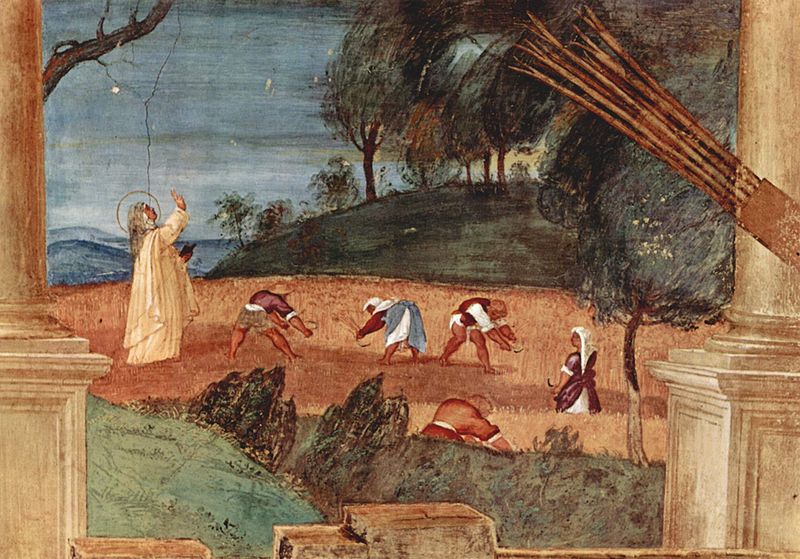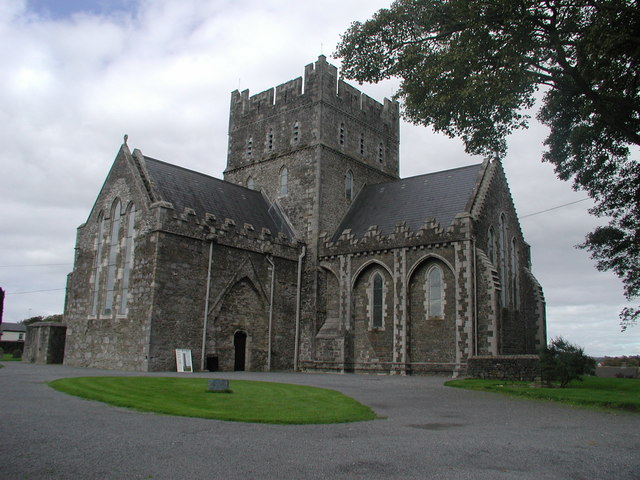Saint Brigid of Ireland
Saints Patrick and Brigid, the two premier saints of Ireland, in St Joseph's Church at Clifden. Photo by James Yardley.
(Incorrectly known as BRIDGET). Born in 451 or 452 of princely ancestors at Faughart, near Dundalk, County Louth; d. 1 February, 525, at Kildare. Refusing many good offers of marriage, she became a nun and received the veil from St. Macaille. With seven other virgins she settled for a time at the foot of Croghan Hill, but removed thence to Druin Criadh, in the plains of Magh Life, where under a large oak tree she erected her subsequently famous Convent of Cill-Dara, that is, “the church of the oak” (now Kildare), in the present county of that name. It is exceedingly difficult to reconcile the statements of St. Brigid’s biographers, but the Third, Fourth, and Fifth Lives of the saint are at one in assigning her a slave mother in the court of her father Dubhthach, and Irish chieftain of Leinster. Probably the most ancient life of St. Brigid is that by St. Broccan Cloen, who is said to have died 17 September, 650. It is metrical, as may be seen from the following specimen:
Saint Brigid was not given to sleep, Nor was she intermittent about God’s love;
Not merely that she did not buy, she did not seek for
The wealth of this world below, the holy one.
Cogitosus, a monk of Kildare in the eighth century, expounded the metrical life of St. Brigid, and versified it in good Latin. This is what is known as the “Second Life”, and is an excellent example of Irish scholarship in the mid-eighth century. Perhaps the most interesting feature of Cogitosus’s work is the description of the Cathedral of Kildare in his day. The rood-screen was formed of wooden boards, lavishly decorated, and with beautifully decorated curtains. Probably the famous Round Tower of Kildare dates from the sixth century. Although St. Brigid was “veiled” or received by St. Macaille, at Croghan, yet, it is tolerably certain that she was professed by St. Mel of Ardagh, who also conferred on her abbatial powers. From Ardagh St. Macaille and St. Brigid followed St. Mel into the country of Teffia in Meath, including portions of Westmeath and Longford. This occurred about the year 468. St. Brigid’s small oratory at Cill Dara became the centre of religion and learning, and developed into a cathedral city. She founded two monastic institutions, one for men, and the other for women, and appointed St. Conleth as spiritual pastor of them. It has been frequently stated that she gave canonical jurisdiction to St. Conleth, Bishop of Kildare, but, as Archbishop Healy points out, she simply “selected the person to whom the Church gave this jurisdiction”, and her biographer tells us distinctly that she chose St. Conleth “to govern the church along with herself”. Thus, for centuries, Kildare was ruled by a double line of abbot-bishops and of abbesses, the Abbess of Kildare being regarded as superioress general of the convents in Ireland.
St. Brigid's small oratory at Kildare (or Cill Dara) became the centre of religion and learning, and developed into a cathedral city.
Not alone was St. Bridget a patroness of students, but she also founded a school of art, including metal work and illumination, over which St. Conleth presided. From the Kildare scriptorium came the wondrous book of the Gospels, which elicited unbounded praise from Giraldus Cambrensis, but which has disappeared since the Reformation. According to this twelfth- century ecclesiastic, nothing that he had ever seen was at all comparable to the “Book of Kildare”, every page of which was gorgeously illuminated, and he concludes a most laudatory notice by saying that the interlaced work and the harmony of the colours left the impression that “all this is the work of angelic, and not human skill”. Small wonder that Gerald Barry assumed the book to have been written night after night as St. Bridget prayed, “an angel furnishing the designs, the scribe copying”. Even allowing for the exaggerated stories told of St. Brigid by her numerous biographers, it is certain that she ranks as one of the most remarkable Irishwomen of the fifth century and as the Patroness of Ireland. She is lovingly called the “Queen of the South: the Mary of the Gael” by a writer in the “Leabhar Breac”. St. Brigid died leaving a cathedral city and school that became famous all over Europe. In her honour St. Ultan wrote a hymn commencing:
Christus in nostrâ insulâ
Que vocatur Hibernia
Ostensus est hominibus
Maximis mirabilibus
Que perfecit per felicem
Celestis vite virginem
Precellentem pro merito
Magno in mundi circulo.
(In our island of Hibernia Christ was made known to man by the very great miracles which he performed through the happy virgin of celestial life, famous for her merits through the whole world.)
The sixth Life of the saint printed by Colgan is attributed to Coelan, an Irish monk of the eighth century, and it derives a peculiar importance from the fact that it is prefaced by a foreword from the pen of St. Donatus, also an Irish monk, who became Bishop of Fiesole in 824. St. Donatus refers to previous lives by St. Ultan and St. Aileran. When dying, St. Brigid was attended by St. Ninnidh, who was ever afterwards known as “Ninnidh of the Clean Hand” because he had his right hand encased with a metal covering to prevent its ever being defiled, after being the medium of administering the viaticum to Ireland’s Patroness.
St Brigid's Cathedral, Kildare. Photo by Vivienne Smith.
She was interred at the right of the high altar of Kildare Cathedral, and a costly tomb was erected over her. About the year 878, owing to the Scandinavian raids, the relics of St. Brigid were taken to Downpatrick, where they were interred in the tomb of St. Patrick and St. Columba. The relics of the three saints were discovered in 1185, and on 9 June of the following year were solemnly translated to a suitable resting place in Downpatrick Cathedral, in presence of Cardinal Vivian, fifteen bishops, and numerous abbots and ecclesiastics. Various Continental breviaries of the pre- Reformation period commemorate St. Brigid, and her name is included in a litany in the Stowe Missal. In Ireland to-day, after 1500 years, the memory of “the Mary of the Gael” is as dear as ever to the Irish heart, and, as is well known, Brigid preponderates as a female Christian name. Moreover, hundreds of place-names in her honour are to be found all over the country, e.g. Kilbride, Brideswell, Tubberbride, Templebride, etc. The hand of St. Brigid is preserved at Lumiar near Lisbon, Portugal, since 1587, and another relic is at St. Martin’s, Cologne.
Viewing the biography of St. Brigid from a critical standpoint we must allow a large margin for the vivid Celtic imagination and the glosses of medieval writers, but still the personality of the founder of Kildare stands out clearly, and we can with tolerable accuracy trace the leading events in her life, by a careful study of the old “Lives” as found in Colgan. It seems certain that Faughart, associated with memories of Queen Meave (Medhbh), was the scene of her birth; and Faughart Church was founded by St. Morienna in honour of St. Brigid. The old well of St. Brigid’s adjoining the ruined church is of the most venerable antiquity, and still attracts pilgrims; in the immediate vicinity is the ancient mote of Faughart. As to St. Brigid’s stay in Connacht, especially in the County Roscommon, there is ample evidence in the “Trias Thaumaturga”, as also in the many churches founded by her in the Diocese of Elphim. Her friendship with St. Patrick is attested by the following paragraph from the “Book of Armagh”, a precious manuscript of the eighth century, the authenticity of which is beyond question: “inter sanctum Patricium Brigitanque Hibernesium columpnas amicitia caritatis inerat tanta, ut unum cor consiliumque haberent unum. Christus per illum illamque virtutes multas peregit”. (Between St. Patrick and St. Brigid, the columns of the Irish, there was so great a friendship of charity that they had but one heart and one mind. Through him and through her Christ performed many miracles.) At Armagh there was a “Templum Brigidis”; namely the little abbey church known as “Regles Brigid”, which contained some relics of the saint, destroyed in 1179, by William Fitz Aldelm. It may be added that the original manuscript of Cogitosus’s “Life of Brigid”, or the “Second Life”, dating from the closing years of the eighth century, is now in the Dominican friary at Eichstätt in Bavaria.
Acta SS.; Acta Sanct. Hib. ex Cod. Salmant.; COLGAN, Trias Thaumaturga (Louvain, 1647); STOKES, Lives of the Saints from the Book of Lismore; ID., Three Middle Irish Homilies; O’HANLON, Lives of the Irish Saints (1 February), II; TODD, Liber Hymnorum; Stowe Missal; Leabhar Breac; MESSINGHAM, Florilegium; ATKINSON, St. Brigid in Essays (Dublin, 1892); HEALY, Ireland’s Ancient Schools and Scholars; STOKES, Early Christian Art in Ireland; HYDE, Literary History of Ireland (1900); KNOWLES, Life of St. Brigid (1907). Cf. CHEVALIER, Bio-bibliogr. (Paris, 1905, 2nd ed.), s.v.
W.H. GRATTAN-FLOOD
1913 Catholic Encyclopedia
Tagged as: Royal and Noble Saints, Saints





No comments:
Post a Comment